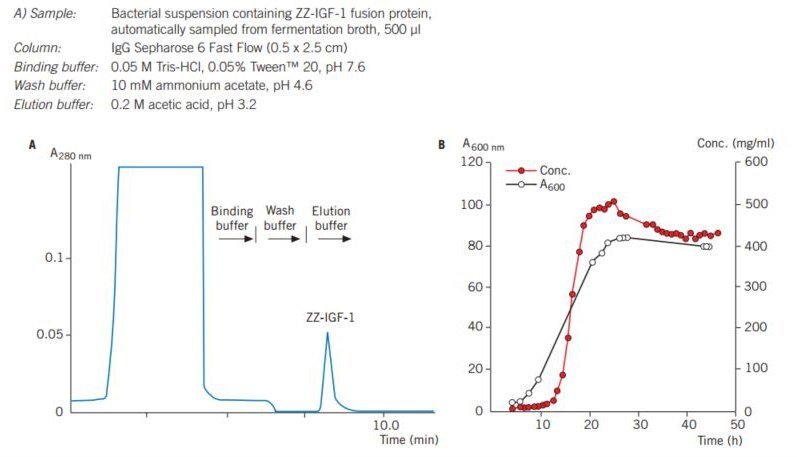Performing a Separation with IgG Sepharose 6 Fast Flow
Purification Option |
|---|
* See Appendix 4 to convert linear flow (cm/h) to volumetric flow rate. Maximum operating flow is calculated from measurement in a packed column with a bed height of 10 cm and i.d. of 5 cm.
Purification Example
Figure 29. shows automatic on-line monitoring of the production of a secreted fusion protein during fermentation. The fusion protein, ZZ-IGF-1 is insulin-like growth factor 1 fused with a derivative of protein A (designated ZZ), expressed in E. coli.

Figure 29.A) Chromatogram of a sample taken at one time point during fermentation. B) Results from automatic monitoring of the product concentration during fermentation. Concentration of ZZ-IGF-1 is determined by integration of the ZZ-IGF-1 peak obtained during each chromatographic analysis. Bacterial density is measured manually at A600 nm.
Performing a Separation
Binding buffer: 0.05 M Tris-HCl, 0.15 M NaCl, 0.05% Tween 20, pH 7.6
Wash buffer: 5 mM ammonium acetate, pH 5.0
Elution buffer: 0.5 M acetic acid, adjusted to pH 3.4 with ammonium acetate
Neutralization buffer: 1 M Tris-HCl, pH 9.0
- Pack the column (Appendix 3, Column packing and preparation for affinity chromatography) and wash with at least 5 column volumes of binding buffer.
- Equilibrate the column with approximately 5 column volumes of binding buffer.
- Wash with 2–3 column volumes of acetic acid followed by 5 column volumes of binding buffer.
- Apply the sample.
- Wash with 10 column volumes binding buffer.
- Wash with 2 column volumes of wash buffer or until no material appears in the eluent (determined by UV absorbance at A280 nm).
- Elute with 2–5 column volumes of elution buffer.*
- Immediately re-equilibrate the column with binding buffer until the eluent reaches pH 7.0 (the IgG may denature if left at a lower pH).
* Because elution conditions are quite harsh, it is recommended to collect fractions into neutralization buffer (60 µL – 200 µL 1 M Tris-HCl, pH 9.0 per mL fraction), so that the fnal pH of the fractions will be approximately neutral.
This method, while giving a concentrated eluate, can be used only if the fusion product is stable under the acid conditions.
An alternative eluent is 0.1 M glycine-HCl, pH 3.0. Chaotropic agents may also be used for elution.
Media Characteristics |
|---|
* Long term refers to the pH interval over which the medium is stable over a long period of time without adverse effects on its subsequent chromatographic performance. Short term refers to the pH interval for regeneration, cleaning-in-place and sanitization procedures.
Chemical Stability
Avoid reducing agents such as 2-mercaptoethanol or DTT since they may disrupt disulphide bonds within the IgG ligand.
Storage
Wash with 5 column volumes of 20% ethanol at neutral pH and store at +4 to +8 °C.
To continue reading please sign in or create an account.
Don't Have An Account?